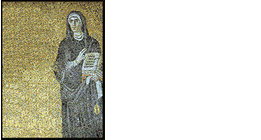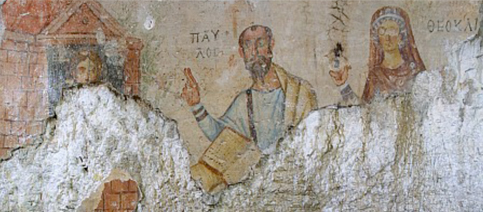 |
|
|
|
| Class
Prep |
|
|
|
- The
Other Legacy of Paul: The Unmarried Woman

- Today's
primary reading takes Paul in the opposite direction from the pastoral epistles
(1–2 Timothy, Titus) and Ephesians. The
Acts of Paul and Thecla is one of many apocryphal works that were
written about Paul and the other apostles. These all circulated widely, but did
not make it into the Bible. (There are several examples of apocryphal gospels
in your book, The Complete Gospels; for apocryphal apocalypses and letters,
you might want to look at Wilhelm Schneemelcher's New Testament Apocrypha
[two volumes] on reserve in the library, or online at the Wesley Center's Noncanonical
Homepage).
-
- Whereas 1-2 Timothy and Ephesians made Paul
into an advocate of marriage and women's silence, The
Acts of Paul and Thecla makes Paul into an advocate of virginity and
uses a woman, Thecla, as the hero of the story. But while the story allows
for women leaders like Thecla (pictured above), it also takes celibacy to a greater
extreme than Paul ever advocated, thereby making Thecla more male than
female. As you read it, make note of places where celibacy is mentioned and encouraged,
and see whether you find the seemingly opposite trait of erotic or sexual content
(you're going to have to expand your imagination here—the 19th-century translator
is uncomfortable with sexual innuendo and so tries to mask it with with euphemisms).
Only after you've tried to find this yourself should you read the excerpt from
Margaret MacDonald's essay in Women and Christian Origins.
-
- Thecla
had a huge following in early Christianity. There was a shrine dedicated to her
in Seleucia, in modern Turkey, and today's Dig Site presentation, if we have one, will present
what is available about that city and site and the more widespread evidence of Thecla in Egypt and/or Rome.
-
-
- Assigned Readings
-
- Primary: Acts of Paul and Thecla (Camino, mostly from Kraemer, Women's Religions in the Greco-Roman World: A Sourcebook)
-
- Secondary: WCO 249-53; online class prep
-
- Slides for Lecture
-
-
- Today's Authors
-
| |
 |
Ross Shepard Kraemer, Professor of Religious Studies and Director of Graduate Studies in Religious Studies at Brown University |
| |
 |
Margaret
Y. MacDonald, Professor of Religious Studies, St Francis Xavier University |
-
-
- Dig Site 3: The Cult of St. Thecla in Asia Minor (Seleucia, Turkey)
-
-
- Further Reading
-
- Davis, Stephen J. The Cult of Saint Thecla: A Tradition of Women’s Piety in Late Antiquity. Oxford: Oxford University Press, 2001.
-
- Hayne, Léonie. "Thecla and the Church Fathers." Vigiliae Christianae 48 (1994) 209-218.
-
- Jacobs, Andrew S. "A Family Affair: Marriage, Class, and Ethics in the Apocryphal Acts of the Apostles." Journal of Early Christian Studies 7 (1 1999) 105-138.
-
- Konstan, David. "Acts of Love: A Narrative Pattern in the Apocryphal Acts." Journal of Early Christian Studies 6 (1 1998) 15-36.
-
- --------. Sexual Symmetry: Love in the Ancient Novel and Related Genres. Princeton, New Jersey: Princeton University Press, 1994.
-
- MacDonald, Dennis R. The Legend and the Apostle: The Battle for Paul in Story and Canon. Philadelphia: Westminster, 1983.
-
- Madigan, Kevin and Carolyn Osiek, eds. Ordained Women in the Early Church: A Documentary History. Baltimore, Maryland: Johns Hopkins University Press, 2005.
-
-
- Links
-
-
-
- Sources
-
- Photograph: Image of Thekla (in her window), Paul, and Thekla's mother Theoklia, from the Cave of St. Paul and Thekla in Ephesus, Turkey. Notice how later pilgrims have poked out the eyes of Theoklia to "punish" her for her spiritual "blindness" in trying to kill her daughter.
-
-
|
|
|
|
|
|
|
